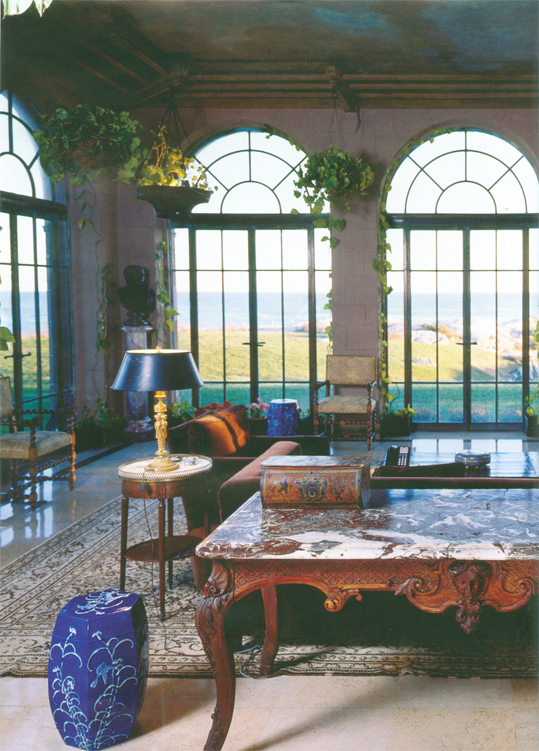June 01, 2018

Doris Duke's Rhode Island Newport home, provenance of FJ Hakimian's Agra rug #09092
In today’s market, the terms “Agra,” “Amritsar” and “Indo-Persian” are synonymous with types of highly decorative carpets, which were woven in India during the last decades of the nineteenth century. The art of pile carpet weaving was imported into India by the Mughals, descendants of the Central Asian Mongols, when they conquered the Indian subcontinent in the sixteenth century. Indian decorative carpets continue the Mughal heritage of fine craftsmanship and their designs feature diverse Mughal and international influences. Undoubtedly the most important external source of design influence and inspiration was English, a result of the countless British merchants, military and civil servants who followed the flag to India and virtually ruled the country from the 1820’s until the mid-twentieth century.
Indian carpet circa 1860 (#09002)
One of the most significant points about Indian decorative carpets is the fact that many, if not virtually all, of these pieces were produced in jails. An actual date for the beginning of the jail production of pile carpets is not known, but the reports of contemporary observers, as well as surviving carpets, indicate that this industry was initiated in the 1860’s. It is not clear whether the first jail weavings were commissioned by Indian aristocrats or ordered by British prison officials.
The greatest catalyst to the development of India’s jail carpet weaving industry was foreign market demand. Indian carpets were first brought to wide scale Western attention through their display at the 1851 Great Exposition at the Crystal Palace, London, with jail carpets from Lahore being displayed to the West in the 1862 London International Exhibition. The major stimulus to the American market for jail carpets was their display at the 1893 Chicago World’s Fair. Jail production boomed in the 1880’s, but the industry gradually declined by the turn of the century.
Agra rug circa India, 1880 (#09073)
Carpets were woven in jails throughout India, and since jail administrators would often take the various design drawings and cartoons of carpets with them when they moved to other jail positions, the designs of different regions soon became integrated into a varied and unique art form. As designs migrated across the country it, also became increasingly difficult to attribute any particular design to a specific jail, causing the clear differentiation between the various Indian weaving centers to blur into somewhat of a single, highly decorative carpet category.
Indo-Persian Rug circa 17th Century (#09038)
One of the most distinctive types of designs seen in Indian decorative carpets is the “Indo-Persian.” The motifs and patterns seen in Indo-Persian carpets are derived from the rich decorative vocabularies of Mughal and Persian art. The well-balanced floral lattice themes, animal combat scenes, fluid arabesque, palmette and vase designs featured in Indo-Persian carpets are based upon the compositions seen in the magnificent sixteenth and seventeenth century Persian and Mughal carpets woven under royal patronage.
Agra rug circa India, 1890 (#09092)
Agra rug #09092 in Doris Duke's Newport residence in Rhode Island.
The models for nineteenth century Indo-Persian carpets were classical Persian and Indian carpets, which had been preserved in nineteenth century aristocratic households in Jaipur, Lahore, Delhi and other sites. In an attempt to revitalize and preserve the artistic tradition of Indian carpet weaving, these classical weavings were often lent by patriotic Indian nobles for reproduction by local workshops.
Another significant design category of Indian decorative carpets derives from shawl patterns like the exquisite, stylized “Paisley” motifs. Such decorative elements were introduced into Indian carpet weaving by shawl weavers who emigrated from Kashmir into the Amritsar region after a devastating famine. With the decline in the European fashion for shawls, the many skilled weavers and dyers of the shawl industry became the next generation of carpet weavers.
Agra rug circa India, 1880 (#09039)
Given the significant British presence, including their work as jail administrators, in India throughout the nineteenth century, it is not surprising that there is a noticeable European, and especially English flavor, to many of the designs featured in jail produced carpets. Much of the British community and many fashionable Indians favored an English style of decoration, and printed cottons, wallpaper and needlework for the European market thus provided the inspiration for jail carpet designers.
For more Indian Decorative Carpets, browse our Antique Indian Carpet Collection.

![09002-[34-0x16-7]-FJ Hakimian 09002-[34-0x16-7]-FJ Hakimian](https://www.fjhakimian.com/sites/fjhakimian/files/09002-%5B34-0x16-7%5D_0.jpg)
![09073-[18-8x13-7] 09073-[18-8x13-7]](https://www.fjhakimian.com/sites/fjhakimian/files/09073-%5B18-8x13-7%5D.jpg)
![09038-[17-0x11-2]-FJ Hakimian 09038-[17-0x11-2]-FJ Hakimian](https://www.fjhakimian.com/sites/fjhakimian/files/09038-%5B17-0x11-2%5D.jpg)
![09092-[17-3x12-11]-FJ Hakimian 09092-[17-3x12-11]-FJ Hakimian](https://www.fjhakimian.com/sites/fjhakimian/files/09092-%5B17-3x12-11%5D.jpg)

![09045-[17-10x13-11]-FJ Hakimian 09045-[17-10x13-11]-FJ Hakimian](https://www.fjhakimian.com/sites/fjhakimian/files/09045-%5B17-10x13-11%5D.jpg)
![09039-[17-3x11-6]-FJ Hakimian 09039-[17-3x11-6]-FJ Hakimian](https://www.fjhakimian.com/sites/fjhakimian/files/09039-%5B17-3x11-6%5D.jpg)